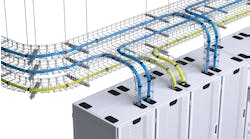Automating Data Center Power Planning with DCIM Software
Herman Chan, President of Sunbird Software, explores how data center infrastructure management tools like DCIM software can help take “the manual effort, inaccuracy, and risk out of data center power capacity planning.”
Herman Chan, President of Sunbird Software
Data center managers often struggle with the complexity of accurately planning and managing rack power capacity. Traditional approaches to capacity planning are time-consuming and unreliable. In the past, this has led to many organizations turning to legacy Data Center Infrastructure Management (DCIM) products that promised to simplify power capacity planning but came up short.
In fact, according to 451 Research, capacity planning and power monitoring are the top two benefits data center managers want out of their DCIM solution. Unfortunately, however, 25% of them reported that their tool failed them and 10% completely abandoned their DCIM project.
Accurately planning data center power capacity is easier said than done, but when organizations are unable to do so, the results are stranded rack power and space capacity and overspending on operating expenses. However, new automation capabilities in modern DCIM software allow for fast, easy, and accurate power capacity planning.
Common Challenges of Data Center Power Capacity Management
In their attempts to plan and manage power capacity, many organizations run into the same challenges that are not easily solved:
- Expensive to build. Building the mission critical, highly redundant power chain to support IT load is expensive—around $15,000 per cabinet. Therefore, any stranded capacity presents a significant cost.
- Mission-critical uptime requirement. Power underpins the reliability and availability of IT services. Data center managers are pressured to properly monitor their power resource capacity and understand the health of their infrastructure or risk devastating downtime. Because of the complex interdependencies within any facility, real-time monitoring across the entire power chain can be a daunting task.
- Available capacity taken for granted. Overbuilding of data center capacity is rampant, largely due to the expectation that the data center should be prepared with ample spare capacity for any unforeseen IT or business needs. This can be a wasteful practice that leads to excessive and costly stranded capacity.
- Lack of information and toolset. Establishing the actual power profile of workloads is difficult, and the monitoring and balancing of critical power resources is often incomplete. Data center managers need to gather the right data to be able to make the most informed decisions when it comes to the efficient use of capacity. Having quick and easy access to highly accurate data is extremely valuable but requires the right tool.
Why the Traditional Capacity Planning Method Fails
Data center managers know that a server device will never consume up to the level of the nameplate rating—the theoretical maximum load the device should ever consume—so common practice is to derate the nameplate value, typically to around 60%-70%, when budgeting for power to determine the maximum number of servers they can deploy in a cabinet.
By automating power capacity planning, you will save time, reduce risk, eliminate stranded capacity, and save money.
This method fails data center managers in three ways:
- Manually intensive. This process is a manual effort. It takes time to calculate the derating for each server model in the data center and then calculate the total budget value for each cabinet.
- Inaccurate. Capacity planning with this approach is based on assumptions with no knowledge as to how the devices are used or what the compute stress is in a specific environment. For example, a financial firm will have extreme peaks during the trading day, but these situations may not always be considered.
- Costly. If the actual load is unknown, no live measurements are being made, and there is no way to know if power assumptions are correct or not, there is a large potential for stranding capacity and overspending on capital expenditures to add new capacity. If it costs $15,000 to deploy a server-ready cabinet, and the traditional method strands up to 50% of space capacity, the result is up to $7,500 in overspending per cabinet.
A Better Way with Auto Power Budgeting
Fortunately, this method is no longer necessary due to recent advances in AI and machine learning technologies now available in second-generation DCIM. A complete solution of DCIM software plus intelligent rack power metering now brings automation to data center power capacity planning and management, making it fast, easy, and accurate.
A modern DCIM solution with an “Auto Power Budget” feature unlocks precious rack capacity as each individual server make/model instance is assigned a unique power budget value that’s automatically set from real-time outlet-measured power readings from intelligent rack PDUs—your devices’ exact loads under your compute stress in your environment. This dramatically refines the traditional method of taking a percent of nameplate and improves the utilization of existing rack power and space.
Where the traditional derated budget method demands high effort and manual calculations, Auto Power Budget takes minimal effort and updates automatically. Where the traditional method provides low accuracy due to applying the same derating to all servers, Auto Power Budget provides high accuracy by using measured readings over long periods of time in its algorithms. And where the traditional approach presents high risk due to error-prone manual calculations and assumptions, Auto Power Budget’s built-in algorithms and validations intelligently manage risk.
Bringing It All Together
As modern data centers become more complex and difficult to manage, organizations must learn to better leverage their data to make smarter capacity planning decisions, or risk stranding capacity and overspending. Being able to automate this process is a key differentiator between a successful data center manager and one who struggles.
Second-generation DCIM software takes the manual effort, inaccuracy, and risk out of data center power capacity planning, making it much easier to deploy more compute power in existing racks, driving additional efficiencies. By automating power capacity planning, you will save time, reduce risk, eliminate stranded capacity, and save money.
Herman Chan is the President of Sunbird Software.





